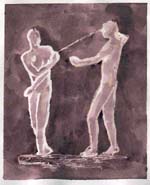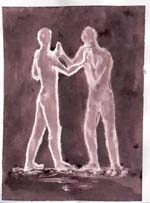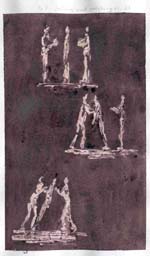Central School of Speech and Drama
d.green@cssd.ac.uk
| Debbie
Green
Central School of Speech and Drama d.green@cssd.ac.uk |
| Rationale:
The workshop
takes the form of a series of exercises for groups of two and three people,
concluding with two whole group exercises. The hour session is planned
to move swiftly from one exercise to the next, with participants changing
partners after each exercise in order for all group members to experience
working with each other.
The session is
designed to launch people into a relaxed, open frame of being group members.
It can potentially short-circuit Tuckman and Jensens' six sequential stages
of group development: Forming, Storming, Norming, Performing, Grieving
and Adjourning and arrive at the Grieving and Adjourning stages at the
end of an hour.
|
| Suitable
for:
Professionals within Higher Education, students (max. group size 20, min. group size 6) |
| Timings:
One and a half hours including reflection and feedback |
| Facilitators:
1 leader/facilitator + 1 other to work if group is an uneven number as there is partner work, otherwise this organiser remains as engaged observer. |
| Resources
needed:
Space for 20 people to move and breathe, furniture cleared, cassette tape player. |
| Running
the workshop:
Stage 1: Physical trust: (28 minutes total - all timings are approximate) Exercise 1
- Back rub: (5 minutes)
Each person is asked to find another partner, with one or two people coming out of the group to observe and fill in the observation and feedback sheet enclosed. This sheet is for personal reflection through the session and is kept by the participant. Exercise 2
- Arm release: (4 minutes)
Each person is asked to find another partner with one or two people coming out of the group to observe and fill in the observation and feedback sheet enclosed. Exercise 3 - Back to back breathing: (4 minutes) Both partners
sit back to back on the floor, making sure the lower backs are together.
It is important that each person is comfortable and each can ask him/herself
what is needed to be more comfortable. For instance, if there is too much
weight against the back making one of the partners lean forward over her/his
legs, does that partner need to assert more weight to find the particular
balance for that partnership? The aim is to sit and feel the support of
the partner's back, whilst noticing her/his breath in her/his own back.
It may be that each can feel the other's breath against her/his back. It
may be that the heights are similar so that they can lean the backs of
their heads together. As the exercise continues the partners might allow
themselves to follow the impulses of movement through the contact with
the partner's back/spine, whilst sitting. The partners are given time to
find their own way to separate.
Exercise 4
- Straw contact: (5 minutes)
Each person is asked to find another partner with one or two people coming out of the group to observe and fill in the observation and feedback sheet enclosed. Exercise 5
- Hand to hand contact: (5 minutes)
Each person is asked to find another partner with one or two people coming out of the group to observe and fill in the observation and feedback sheet enclosed. Exercise 6 - Falling and catching in 3s: (5 minutes) A group of 3
form a line with the two outside people facing into the middle person and
with a small distance to start with between them all. The person in the
middle falls like a tree i.e. in one unit, forward 'into' the person in
front of them. This person receives the fall and gently uses this taking
in the weight to push the middle person backwards into the hands and the
'body' of the other person behind. This second catcher 'rescues' the falling
middle person and the pushing and receiving continues between the person
in front and the person behind. What does one need to do to be more comfortable
but still do the task? The distance apart need only be small but it is
important to allow the middle person to truly fall and not be guided or
controlled into the hands of the person either in front or behind. Roles
must be changed so that each person experiences the falling.
One/two people come out of the group to observe and fill in the observation and feedback sheet enclosed. Stage 2: Group exercises: (35 minutes total) Exercise 7
- Balancing the space: (5 minutes)
One/two people come out of the group to observe and fill in the observation and feedback sheet enclosed. It is important that each member of the group be observer and so anyone who has not observed should give themselves the opportunity to do this in this final exercise. Observers can feed back into the action again if they want. Final Exercise
- Group move: (5 minutes)
Once a group feel has developed, further instructions - "fast, medium, slow" can be added. The above can produce creative work, and has the potential to provide conflict, but also degenerate into a power game between members of the group over the direction calling. Exercises like this can elicit all sorts of group behaviour issues, which can contribute to the development of self- awareness. All group games can reach the stage of familiarity and there is the potential for them to become boring. They can, though, be taken on into something quite extraordinary and subtle if the group wants this creative approach or if the facilitator is skilled in choosing and changing the activities to suit the group's needs. Pina Bausch's dance theatre piece 'Café Muller' contains an example of trust at its most 'dangerous', with a blindfolded dancer dancing in an abandoned way around the stage full of objects and with another performer having to move the obstacles out of her way, alert to her every move and whim. This demands a heightened sensitivity to others and a profoundly well-developed performer's group consciousness. Stage 3: Reflection
time: (5 minutes)
Stage 4: Group
feedback: (20 minutes)
|
 |
 |
|
 |
|
 |
|
 |
|

Pictures by Yasuko Hasegawa |
|
| Guidance
notes and recommendations:
Advice and warnings
for facilitators:
|
| Further
Notes:
Our acting students can build critical attention and skill in articulating by witnessing and involving themselves with another's work. Contact Improvisation involves work in couples and changing partners regularly throughout the session so that different experiences can be drawn from and reflected upon. Students are also introduced to a system of buddying in the first and second years on the BA (Hons) Acting course, CSSD, which is about 'being there' for the partner throughout each term's work. The confidence that is developed by working in twos is evident early on in the first term, with each partner practising giving close witness or attention to the work produced by the other. Through this process, self-awareness grows and feedback skills are developed with the result that communication can feel liberating. The ability to offer constructive criticism becomes the practice. This workshop has been devised with this process in mind, with opportunity for experiencing working with each person in the group, self-reflecting, as well as feeding into the group endeavour. |
| Bibliography:
(R1)
Bryan, C. & Green, D. 'how guided reflection can enhance group work'. (paper) Tuckman, B.W. & Jensen, M.A.C. (1977) Stages of small group development revisited, Group and Organizational Studies, 2, 419-427 |
| Comments
from participants:
"Enjoyed real
experience. Found trust exercises very useful demonstrations. The
"it's a smashing
session and one I am glad I experienced and feel privileged to now
"I have never
done any physical work of this sort and approached the session with
|
Debbie Green
FDTL - Assessing
Group Practice
Central School
of Speech and Drama
Nov 2002
d.green@cssd.acc.uk